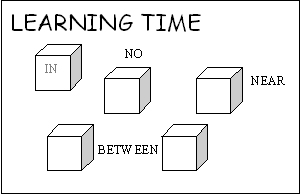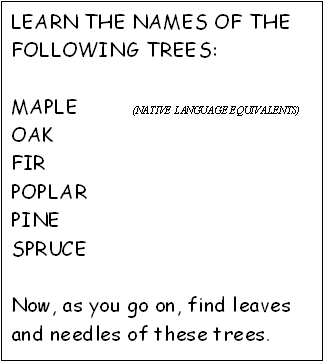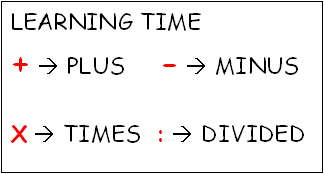
English Through Orienteering
Anna Turula
Anna Turula, PhD. ELT has been a teacher and teacher trainer for 19 years. At present she is a trainer with the Department of English, University of Bielsko-Biala, Poland. E-mail: anturul@poczta.onet.pl
Menu
Introduction
Theoretical back-up
From theory to practice
Why do English through orienteering?
Introduction
English through orienteering® was invented for fun. It was a part of the English Homeschool project my friend Bozena Pawlowska and myself started in 1999 to teach English to our own - as well as our friends' - children. We soon realized that, in addition to language lessons held at home, it is a good idea to take our little learners outdoors. The main idea was to prevent our flats from being totally vandalized by the young eager minds with even more eager bodies; the pedagogical implications included: more freedom for the children, more educational possibilities and, as already mentioned, more fun.
As an activity, English through orienteering is based on a typical scouting game in which there are two parties: the escaping group and the group that is supposed to track the escapees. Those who run away leave different signs and letters which are to help the search party to find their way around. Once caught, the escapees become the search party and the game continues. Our modification was that the language of the instruction in the game is English. As some instructions in the game require specific knowledge of the foreign language, the tasks in English through orienteering are divided into LEARNING TASKS and DOING TASKS. In order to be able to carry out a DOING TASK, the players need to learn something first. That is why, each group is accompanied by an English-speaking adult who tutors them, if necessary, in LEARNING TASKS but is not allowed to help them in DOING TASKS.
Now that I have decided to share the idea with fellow teachers, I am going to supplement the fun with some theory-philosophy prerequisites. First of all, because every idea looks more reliable with serious theoretical back-up (;)). Secondly, and more importantly, learning through playing is important but fun is a means to an end and not the end itself. Consequently, it is necessary to know that while making our lessons enjoyable we are still moving along the pedagogical lines that are conducive to learning.
Theoretical back-up
As a language teaching activity then, English through orienteering is based on the following general and language schooling ideas and methods:
- Total Physical Response. First of all, TPR, as a method, is based on a general approach called "the comprehension approach" stemming from the assumption that understanding should precede production, the latter expected to appear spontaneously. In English through orienteering the way the game goes on very much depends on comprehension - success in the game depends on how well its participants understand the instructions of the left-behind traces. Secondly, in light of TPR, children learn best if language instruction is related to bodily-awareness. Taking the idea outdoors offers endless possibilities as to what kind of instruction children may respond through actions. What is even more important is the motivating factor - they have a reason to respond in the requested way - winning the game.
- Experiential learning. "Tell me and I'll forget; show me and I'll remember; involve me and I'll learn". In the area of learning by doing the above-quoted Chinese proverb refers to the methodological foundations of TPR. However, there are two sides to experiential learning. The first, already discussed, is that one learns best by being active. The other means that instruction is most successful when relying on the learners' previous experience. That is why language education - as any other type of schooling - is most conducive to success if it bases on the learners personal resources - what they already know, what they are interested in and, generally speaking, who they are. Both aspects of experiential learning can be implemented in English through orienteering. Learning by doing has already been discussed. As to relying on the learners' experience, numerous tasks in the outdoor game can be devised on the basis of the computer games the children play, books they read or films they have seen.
- Language Across the Curriculum. As a language teaching idea, LAC stems from Content Based Teaching, an approach which sees the language as a means to an end and not an end in itself. To cut a long story short, language is a vehicle for content. Such a view seems most appropriate in young learner education as children rarely appreciate learning the language for the art's sake. Taking the idea outdoors offers the opportunity to integrate English with subjects like nature, geography, mathematics and sports.
- Outdoor education. Out-of-school lessons, though not a standard (yet), are becoming more and more popular. It has been discovered that if not equipped with certain outdoor experience when very young, students have problems understanding more abstract relationships in science in their later years at school. That they do not have the experience on their own or with their parents is a fact resulting from the popularity of certain indoor pastimes, sitting glued to the computer screen heading the list. The principle of outdoor education is that children go out of school - on regular basis - and learn subjects like mathematics, the native tongue, science, arts and others during several-hour-long outings. Teachers who use this method notice that when outdoors, the students are more autonomous, collaborative learning prevails over competition and discipline problems are easier to solve. English through orienteering adds the foreign language to the above list of subjects.
From theory to practice
To prove that the theory-philosophy roots are real, let me present a typical English through orienteering game.
As mentioned before, the search party relies on signs and letters left by the escapees and all the instruction is in English. A typical trace - left as a letter or chalk-written on the pavement may be
Trace 1

or, as both parties are equipped with compasses and trained to use them,
Trace 2

Another option is
Trace 3

Such traces may be modified to involve skills like error correction:
Trace 4

or
Trace 5

where the learners' knowledge of spelling is critical to finding their way around. As I said earlier, some instructions, in order to be understood, need learning some language material beforehand. That is why, the two consecutive steps combining a LEARNING TASK and a DOING TASK may be:
Trace 6

Trace 7

Sometimes the LEARNING/DOING combination will require more expertise in other school subjects like nature:
Trace 8

followed by
Trace 9

Or arithmetics:
Trace 10 
Trace 11

Sometimes, following the right instruction will require relying on background knowledge:
Trace 12

Out of these three boxes only the right one contains true instructions. The messages from the other two will be misleading or nonsensical (GO HOME AND DO 25 PUSH-UPS).
Occasionally, in addition to being visually alert (all traces are not so easy to notice) and intellectually involved in doing language and cross-curricular tasks, the learners have to rely on their aural abilities, as in the following LEARNING/DOING combination:
Trace13

followed by
Trace 14

When the search party locates the escapees, all children (and adults) have a short picnic. Then the parties swap and the second part of the game begins.
Why do English through orienteering?
The most important reason for teaching English to children by means of this old scouting game is that it is an out-of-class activity. In consequence it guarantees all the benefits outdoor education: contact with nature, freedom, physical activity on the one hand and, on the other, autonomous and collaborative learning, peer tutoring and learning through play. What is more, learning a language is meaningful - you need the linguistic resources to play and win; language education is cross-curricular - the knowledge of mathematics, nature and many many others (not discussed in this article because its format cannot accommodate for all the possible task samples) is as necessary as your ability to understand the foreign language; language learning is experiential in both meanings of the term - children learn by bodily-awareness as well as relying on their own experience. And finally, in spite of all the theory-philosophy foundations, learning English through orienteering is still enormous fun. For learners and teachers alike.

Please check the Building Positive Group Dynamics course at Pilgrims website.
Please check the Creative Methodology for the Classroom course at Pilgrims website.


|